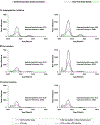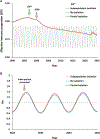Modeling Poliovirus Transmission and Responses in New York State
- PMID: 37596838
- PMCID: PMC11284859
- DOI: 10.1093/infdis/jiad355
Modeling Poliovirus Transmission and Responses in New York State
Abstract
Background: In July 2022, New York State (NYS) reported a case of paralytic polio in an unvaccinated young adult, and subsequent wastewater surveillance confirmed sustained local transmission of type 2 vaccine-derived poliovirus (VDPV2) in NYS with genetic linkage to the paralyzed patient.
Methods: We adapted an established poliovirus transmission and oral poliovirus vaccine evolution model to characterize dynamics of poliovirus transmission in NYS, including consideration of the immunization activities performed as part of the declared state of emergency.
Results: Despite sustained transmission of imported VDPV2 in NYS involving potentially thousands of individuals (depending on seasonality, population structure, and mixing assumptions) in 2022, the expected number of additional paralytic cases in years 2023 and beyond is small (less than 0.5). However, continued transmission and/or reintroduction of poliovirus into NYS and other populations remains a possible risk in communities that do not achieve and maintain high immunization coverage.
Conclusions: In countries such as the United States that use only inactivated poliovirus vaccine, even with high average immunization coverage, imported polioviruses may circulate and pose a small but nonzero risk of causing paralysis in nonimmune individuals.
Keywords: New York; immunization; modeling; outbreak; polio.
Published by Oxford University Press on behalf of Infectious Diseases Society of America 2023.
Conflict of interest statement
Potential conflicts of interest. All authors: no reported conflicts. All authors have submitted the ICMJE Form for Disclosure of Potential Conflicts of Interest. Conflicts that the editors consider relevant to the content of the manuscript have been disclosed.
Figures



References
-
- The Lancet Editorial Board. Polio eradication: falling at the final hurdle? Lancet 2022; 400:1079. - PubMed
-
- Centers for Disease Control and Prevention. Poliomyelitis prevention in the United States. Updated recommendations of the advisory committee on immunization practices. MMWR Morb Mortal Wkly Rep 2000; 49:1–22. - PubMed
-
- Thompson KM, Duintjer Tebbens RJ. Retrospective cost-effectiveness analyses for polio vaccination in the United States. Risk Anal 2006; 26:1423–40. - PubMed
Publication types
MeSH terms
Substances
Grants and funding
LinkOut - more resources
Full Text Sources
Medical

